 Facebook
Facebook
 X
X
 Instagram
Instagram
 TikTok
TikTok
 Youtube
Youtube
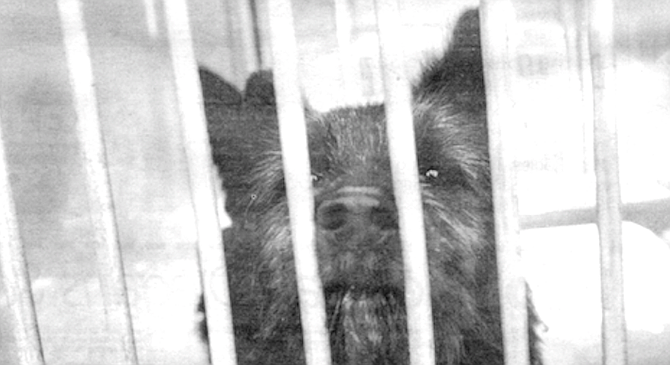
It’s become a bona fide good job. It starts at $18,678 U.S., then cranks in with regular 5 percent increases, You get medical, dental, and vision care benefits, two weeks’ vacation, sick pay, and retirement. Fifteen years from now people will look back at this job and marvel that blue-collar workers lived so well.
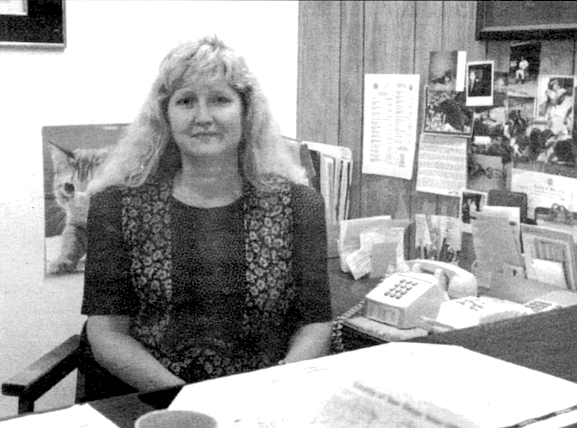
There’s a bit of work to be done at Animal Control: patrol, education, vaccination, licensing, rescue, sheltering, and adoption, for openers. The department estimates that one million dogs and cats live in San Diego County, and they are invisible, that is, they don’t get in people’s way.
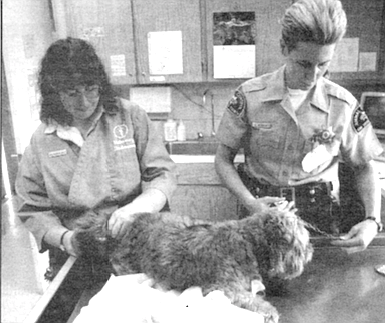
There hasn’t been a reported case of rabies in San Diego County in generations. We complain about cops, school teachers, building inspectors, tax assessors, CalTrans, and evil incarnate — the U.S. Postal Service — but no one complains about animal control.
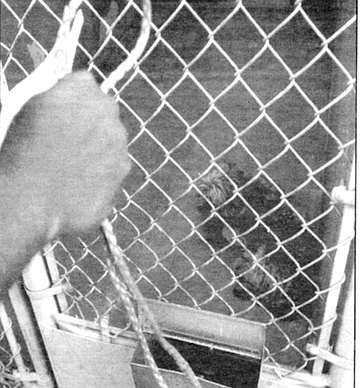
When you walk the animal shelter grounds — at least the grounds on Gaines Street — you are struck by the care employees have taken. You notice the old, small, but immaculately maintained buildings, the lovely murals hand-painted on kennel walls, the individually crafted signs and touches in the cattery. This is a place where people care, and it shows.
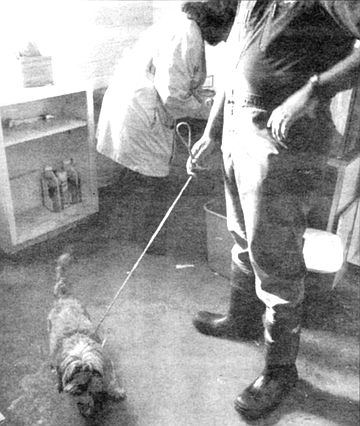
There is an underside to the job that people don’t talk about, and it takes up a significant portion of the work day. It is a necessary task. In six years, one female cat and her offspring can theoretically produce 420,000 cats. One female dog, same period, same theory, can be matriarch to 67,000 pups. Someone must deal with the unwanted, the surplus, the sick. The solution is to euthanize animals, thousands of animals. San Diego County’s Department of Animal Control euthanized 27,841 dogs and cats in 1991-92. Or, to use one of the English language’s triumphant euphemisms. Animal Control “put 27,841 dogs and cats to sleep.” It is, of course, hardly sleep; it is death.
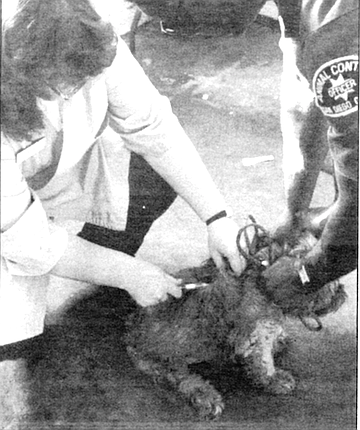
So what’s that like?
Before us is a tall, trim,- 38-year-old African-American woman. Her black hair is short; she wears big, round, dark sunglasses, which highlight a shy but wide smile. The woman is wearing the khaki shirt of an Animal Control officer. On her right shoulder is a large police-type patch, and over her heart, another patch, shaped in the form of a badge. She stands “at ease," hands clasped behind her back, and speaks in a soft, sincere voice.
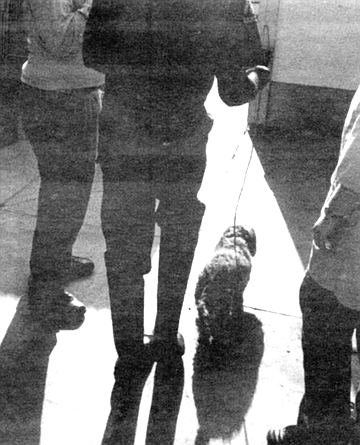
“My name is Debbie Moore. I was born in San Diego. I went to Point Loma High School, graduated in 1973. I trained to be a secretary in high school, but I didn’t want to work behind a desk; I don’t care that much for people.

“I’ve had animals since I can remember. I’ve never been without an animal. I’ve worked for a veterinarian, that was ’78, and again in ’84 and ’85. I assisted in surgery and groomed animals. In between I was an obedience trainer, dog-trainer, things like that.
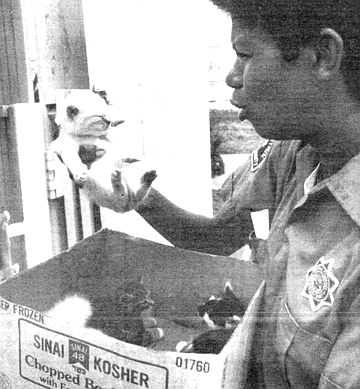
“I got this job in ’88. I’m a single parent, and at that time I was on welfare and it was just getting to me. It was Women’s Opportunity Week, and I figured, ‘Well, I’ll go on down and check it out.’ There were a bunch of booths set up in an auditorium, different organizations were recruiting women for various jobs. I had my daughter Amber strapped to my back, and I went over to the Animal Control booth and I thought, ‘Well, this a good idea.’

“I’m an Animal Control officer. I like it, I like to stay with the animals. I come into work at 6:30 a.m., do a check and see if all the gates are locked, see if all the animals are alive, check the ones that are on medical hold, things like that.
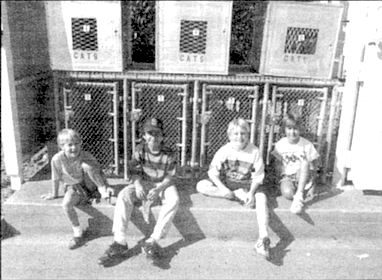
“Then I open up the cages and start cleaning cats. We pull them out, put them in little bitty cages, clean the kennel, stock food and water, and put in fresh litter. We take everybody’s dish out and clean it because of all the cats coming through — they have viruses and some of them are shedding. That takes three to four hours, from 7 a.m. to 11 a.m.
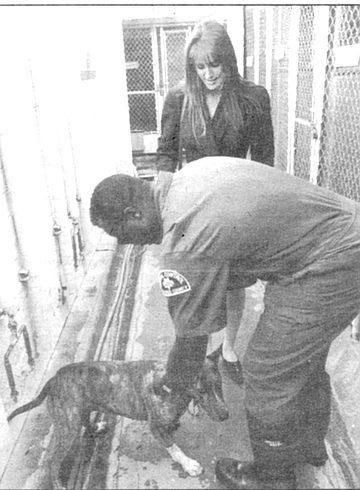
“Sometimes the cats are ornery. Like today, I was cleaning the cat cage and a cat hit the door and ran right up the wall. You have four feet coming at you and the claws are extended and they’re very upset. One hid up in the turbine, and I had to get the catch pole and try to pull him down, and that was hard.
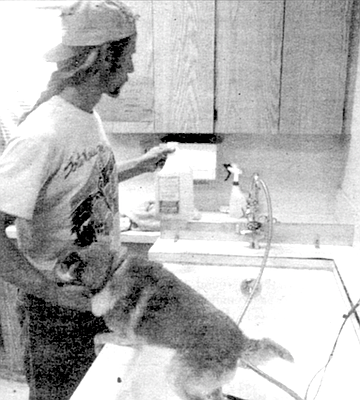
“Sometimes when we’re cleaning cats, we have mothers in there, and they’re so stressed that they start giving birth. Then we have to pull the other cats out of the kennel. Occasionally we’re dealing with a wild cat that’s swatting at you, and you have to go in there and try to get the babies that are hooked to the umbilical cord, deal with the placenta and stuff like that. It’s one of those, ‘Help! Help!’

“We snip the umbilical cord. We take the little kittens out and tie the umbilical cord off and then cut the placenta. Then we put the kittens back in with the mom and hope that she nurses them.
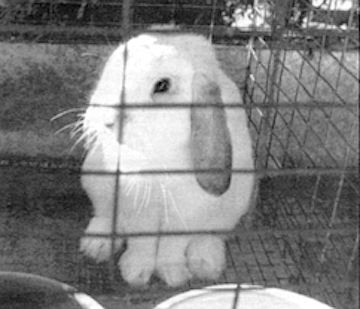
“At 11:00 I have lunch; I make it at home, save some money that way. After lunch I read. I’ve got a computer book that I study. I bought a computer for my daughter, so I can share that with her. It’s an IQ computer. It looks like a little typewriter, and I’ve got the printer. It has everything in there that your basic computers have, but it teaches you, and this was $209!

“After lunch we’re impounding animals. Sometimes owners bring their animals in if they don’t want them anymore. The way it works, somebody drives in, puts his dog in one of the cages out in the parking lot. Then they come to the front desk and say, ‘I’m releasing my dog,’ because of whatever the problem is. The office calls us, we get the dog, vaccinate it, tag it, put it in the kennel, and then put it on the computer. If the animal was released because of old age, we would go ahead and euthanize it. We have to get a captain or lieutenant to authorize that.
“In the mornings we put them to sleep. I think I’m dealing with the process a little bit better. In the beginning, it was hard, putting so many of them to sleep.
“I don’t have nightmares. Once in a while a dog will stick out in my mind, and I’ll take it home, but it still hurts every time. A lot of people don’t understand; I take care of them like they’re my pets. That’s how I see it. I’m going to do what’s best for them. And we have so many that come in. I know that they’re going to be a lot better off euthanized. That helps me deal with it.
“I still get emotional. I do. Some of them I can’t euthanize. I’ll ask a coworker, ‘Can you please do this one for me?’ But you still feel sad, because a lot of them are struggling. I’ll hold it and talk to it and kiss it and cuddle it because that’s the last time it’s ever going to feel that emotion.
“By the time you come out of [the euthanizing room], you’re tired and exhausted, physically and mentally, because there’s just so many of them, you can’t put them all in adoption, and some of them are sick. There are others that you’ll look at and say, ‘Well, I’m sorry, I cannot put this one to sleep,’ or, ‘I can’t do one more.’ Sometimes we do that. I think we all do that. It’s because the list is so long, and they’re squirming, and it just takes a lot out of you.” She sighs. “Sometimes, instead of putting one to sleep, you go ahead and stick him back in the kennel. That makes you feel good.
“Every once in a while one of the dogs that was supposed to be put to sleep will get adopted. That’s really neat, that’s why I try not to hurry the list because maybe somebody might come in and adopt the dog. It’s happened. It has happened so many times. We all go, ‘Oh, all right!’ It’s just wonderful.
“I have three cats at home and a rat and a hamster that were once in that room. I said, ‘I can.’t do it,’ and I took them home. I foster anything that I can, because we don’t have the space. We don’t have enough foster people either. I have a house, so I can foster four- or five-week-old kittens or puppies. I get them to where they’re eating on their own and potty-trained, then I bring them back to be adopted. If I didn’t, then that whole litter would have been euthanized.
“I like to do the cats because they go down much easier, much nicer. I talk to them as I’m injecting them and kind of scratch them real hard on the leg and that takes their mind off it a little bit.
“I like the job. The only thing I don’t like is the euthanization part. I have a lot of feeling behind me, I mean, I do extra things around here, I do the fostering. I don’t make that much money, but the money that I do make, I buy cat food or little toys and things just to make their stay here better, even if it’s only three days. I make sure they’re getting good nutrition, especially little kittens. All that comes out of my pocket, but it makes me feel like I’m contributing something, at least to the animal world. I wish I could do more.
“After lunch 1 impound animals and help with adoptions. If people want a dog, we’ll go out and show one to them. There’s chores to be done like cleaning kennels or sanitizing kennels. All day long we’re impounding dogs and cats as they come in from the public. I leave at 3:30. It’s like, ‘Bye, guys, I did my chores, I did my duty.’ ”
Every job has a boss. One of the bosses at the Gaines Street shelter is a 30-plus, blonde, 5’6" woman. You are introduced and think, “determination and focus.”
“My name is Theresa Williams. I’m a captain in the department of Animal Control. We keep animals by looks, by personality, and by age. We have an adoption counselor that’s involved in those decisions, the volunteers give us their input, the kennel officers choose the ones they like, and I have my input. We all pick, we all have our favorites. If an employee wants a particular animal to go into adoption, they’ll come and say, ‘Look, I really like this dog, is there something that you can do?’ We’ll put it on our adoption list. Those animals are checked by our medical staff. They’ll go through all those animals and say, ‘Okay, this one has a skin condition,’ or ‘This one can’t go into adoption because it’s got some kind of tumor,’ or ‘It’s got an ear infection.’ They weed out all the ones that have medical problems. What’s left and what’s healthy are either spayed or neutered or go directly into adoption. All the cats are spayed and neutered.
“We average about 90 cats a day in the summer. On any given day, all three county shelters will have anywhere from 400 to 600 animals. In the wintertime that’s drastically reduced. Here, out of those 90 cats, we keep, typically, no more than 6. We have such a small area; if we keep more than 6, the cats go downhill much quicker. The more stress they have, the more likely they are to get sick and start having diseases. And once one starts sneezing or coughing, then we have to immediately pull that one out, and usually every single neighboring cat has been infected, and we have to pull them all out and put them to sleep.
“This is where we euthanize the animals.” We walk through an unmarked white door, take a few steps past a row of silver metal cages (five across, stacked three high) into another small room. This is the business chamber. Cement floors, white walls. It’s a small room, maybe 10-by-14 feet. Fastened to the far wall is a small, shiny, stainless-steel folding table, like the built-in ironing boards you would find in an older apartment. Three feet away is a floor cabinet with a computer on its top. Above are storage shelves. Hanging on the cabinet's side is a black phone. The room has one window, partially open. The effect is bleak, barren, and appropriate.
“Right through there,” she points to a passageway on the far side of the steel table, “we have a large walk-in cooler where we keep 50-gallon drums. We put the dead animals into the drums, and two or three times a week, dead animal removal comes and picks them up. Usually the barrels are chock full. We have nine barrels right now; if we need more, we ask for more. A private agency removes the animals; they’re contracted with the city and , the county.
“Only one or two outfits in San Diego do this. They put the bodies in big trucks and haul them to a rendering service, either in El Centro or L.A. They render the animals there. They cremate some of them. They make things out of the bodies. I’m not sure what all that entails. But they take all animals, not just animals from animal shelters; they have livestock and horses too. It’s my understanding that they break the animals down to use for certain types of fertilizer. They can’t be used for food products since most of the animals have been chemically destroyed.
“We have to make sure that the walk-in cooler stays at a particular temperature at all times. When they pick up barrels, they leave empty barrels. At that time we scrub everything down with disinfectant.
“When I started here in 1976, we used high-compression chambers instead of injections. Now we use a chemical injection, which is sodium phenobarbital, and it’s a barbiturate, so we overdose the animals. We inject them in the vein on the front leg. It’s a very peaceful and calm way to go.
“In the old days, when I worked in the kennels, we had two high-compression chambers that we put the animals in, one animal on each side, and we pushed them in, closed the door, cranked the doors shut, and sucked all the air out of the tank.
“They would die of suffocation. It was a humane way to go in that it did not cause the animal physical pain. Personally, I had a horrible time with it. It did not cause them pain because they got real dizzy, a euphoric feeling, passed out and died while they were unconscious. But it was a very difficult way to do it for me because the animals were frightened during the whole process. And if an animal is frightened, then it’s not humane.
“I’ve done this for 16 years. I came to San Diego from upstate New York and volunteered because 1 wanted to help animals. I finally got hired. I was going to save the world. I was going to help the animals and I was going to make a difference, and what I was asked to do — in those days our euthanasia rate was much higher; it would take us all day long to do euthanasia — every single day, all day long, in those high-compression chambers... I was appalled. It was horrible.
“This is their last stop. The animals in those cages over there,” she nods towards the three-tier rack of cages. “They’re all going to be put to sleep this morning. The last thing they’re going to see when they leave this world is an Animal Control officer that’s holding them and talking to them.
“We try to do all of our euthanasia in the morning before we open for the public. By 9:30 we have all our euthanasia done. Now, throughout the day, people will bring us animals requesting that we put them to sleep or animals that are injured that must be put to sleep. We’ll do that throughout the day, so the officers that work in the kennels are never relieved of the duty. They have to do the euthanasia constantly. They do mass numbers in the mornings and then throughout the day. The numbers range anywhere from 20 on our list to 80 or more.
“Now as far as depression goes, every single person handles euthanasia differently. I would not trade in my dog for anything in the world, and I truly love animals and have a great deal of compassion and concern for animals, and yet, I am a person who can successfully do this.
“When I first started, I was very young. I justified it in my mind by saying, ‘If these animals are not put to sleep, there’s no place else for them to go. They won’t go into homes where people care about them because there aren’t enough homes. There is no other place for them to go but to sleep. There is nothing else that we can do with these animals. These are surplus animals, nobody wants them.’ So I justified it in my mind by saying that.
“When we went to the injection method, I was ecstatic because then I could hold the animal, I could pet it. It would die in my arms rather than a cold chamber with nobody touching it, all by itself and frightened. To me, that was the worst of the worst.
“Like I said, I have been working here for 16 years. I have had times when things have bothered me a great deal, although I can’t really say I’ve had nightmares. I have had dreams that have been, at times, unpleasant. But if you are successful in this business, you are able to deal with the stress. And there is stress, but I don’t go home and have nightmares. There are a lot of things that bother me, and I’m not going to tell you I’ve never cried, because I have. At certain times you’re more sensitive than at others. When I lost my dog a couple years ago — I had my own dog put to sleep — after that every time I saw an old dog, I practically fell down. Certain animals just get to you. There’s always that one animal you want to save.
"As far as putting animals to sleep, I have a real problem with old dogs because they have lived a long time, they don’t deserve this, that’s my personal sensitivity. We have a girl that has a particular sensitivity to certain cats. She’ll say, ‘I can’t do this one today, you’re going to have to do this one or get somebody else to do it.’ That’s acceptable. It’s understandable. We don’t want people to work here if they don’t have those feelings, because if they never have those sensitivities, what are they doing putting animals to sleep? I don’t want people to work here and not feel, every single day, that what they’re doing is important, that they have an obligation to the animal. The animal has not been treated right, there’s no reason the owner shouldn’t keep this animal until it dies of old age, but it’s here, it’s waiting to die, and the last human hands that touch it have to be compassionate. That’s our obligation.
“We try to schedule it so you don’t have to do it every day. We can switch things around. The other side of that is we have a job to do, we’re paid county employees and if you can’t handle this job, then you shouldn’t be in this job. We don’t want — two years from now or five years from now — to have an employee with those nightmares.”
Captain Williams walks over to the chamber’s computer. “This is our computer. We put the animal on the table. One person stands behind it and holds it, one person operates the computer. This dog,” she refers to a young chow in a nearby cage, “is tagged as number 388.” Quick hands tap, tap, tap on the computer keyboard. “We pull his number up. The person who’s operating the computer looks at the dog,” Williams studies the screen, “and says, ‘Okay, this dog was signed off yesterday. The information indicates that everything is okay for this dog. The computer says it’s a chow mix, a tri-color, a female, about one year old.’ You look over to the holding cage and say, ‘Yes, I can see that it’s a chow mix, it’s definitely tri-colored, and it’s a young female.’ And you look for any other information on the more screen, which means there’s more information on the animal, and all that tells you is the name of the person who brought the dog in. There’s nothing here to indicate that I shouldn’t put the animal to sleep. The captain has signed off. So it’s okay to go, therefore. I’m going to do it. It’s done. It’s time.
“We pull up the syringe. For her particular size we’d probably use six to eight cc’s. We put the mixture in the syringe. The person standing at the table holds the animal from behind, with one arm under the chin and the other holding her leg. That person would hold off the vein for the injector. They roll the leg over, and the vein will pop up when they put pressure on it. You can see through the hair on most dogs. Dobermans, rottweilers, shepherds are easier dogs to do. You inject into the vein. Once you get blood into the syringe, you know that you’re in the vein. The person who’s applying pressure releases the pressure but still holds the elbow of the animal. The injection is done and the animal falls to sleep.
“It usually takes seconds. Normally the animal is already down before you finish injecting. Sometimes you’ll have problem animals, for instance, animals that are extremely old. They have very low blood pressure so their pumping action isn’t working effectively, so sometimes they take longer. Animals that are extremely agitated, their adrenaline is working, they can take longer. And occasionally we get a bad batch of serum. It happens every once in a while.
We’ll inject the animal and it sits there and looks at you like, ‘What’s next?’ So then we have to inject it again. That’s always difficult, especially if you have an animal that’s not cooperative. Most animals are cooperative. We don’t have a lot of problems, but on a daily basis there’s one or two that we’ll have to muzzle or put a catch pole on.
“Once the animal has been put to sleep, we place it on the floor right behind us, behind the curtain. We keep the curtains closed because we don’t want the other animals to see what’s going on — a philosophical decision that we’ve made. We don’t immediately put the animal into the cooler as an extra added test. We wait and make sure it’s dead. When it goes down on the table, the person who’s handling the animal checks the eye response to see if there’s any reflex in the eye, makes sure the eye has dilated completely.
“When the animal dies its pupils expand, we look for that. We check their mucous membranes to see if they’re pale in color, because the blood should be drained out at that time, and then we just wait for a second or two and check for a heartbeat. Then we put the animal on the floor. After it’s been on the floor, usually for 20 minutes, after we do several more, we’ll line them up and put them into the cooler.
“Sometimes we’ll get feces or urine on the table when they release themselves, but most of the animals are put to sleep before they’re fed in the morning. We get all the animals pulled and ready to go before 9:30. After 9:30 we no longer pull animals because there’s always a remote possibility that somebody will come through and adopt one of the dogs that was scheduled to go.
“We had a guy that retired from here after 25 years in the kennel. Think of the number of animals that he’s put to sleep. I think that affects you in your life, I really do. As a manager, if you’re a person who comes in every day to put animals to sleep and you don’t care, then I’m going to watch you carefully. If you don’t feel anymore, I don’t think you’re healthy anymore. I would watch you very carefully because I want to make sure that you’re here doing this in the most compassionate way, that you’re taking the extra steps — to pet the dog, talk to the dog, make the dog feel more comfortable.”
We are in the employee break room at the Gaines Street shelter. It’s a pleasant spot. First glance registers a dark-brown cafeteria table surrounded by chairs, a couch, a fridge, a rack of lockers, posters on the wall. Sitting across the table is a mature male, 5'8", gray hair and mustache, glasses, clean-shaven, barrel chest, wearing olive-green shirt and trousers. He presents a serious expression, a science teacher’s expression.
“My name is Art Hurteau. I’ve been here for five years. I’m 59 years old. I was born in Minneapolis, Minnesota, a long time ago. I’ve been all over since then, of course.
“I was a farmer in Missouri for 12 years, part-time; worked in a factory too. We had 80 acres. It was a cow/calf operation because the land was mostly grass. It was in the Ozarks. My wife became ill, and the doctor said it would be best to get her away from where it was so quiet, so we moved back to San Diego where we first met in 1957.1 guess my experience with livestock helped get me this job.
“When I come in to work, it’s a major cleanup, like on a farm. You've got to clean all the animals, first person that arrives, they open the place up and start on the cat cleanup because that’s the most labor-intensive. We're fortunate we have some help from the Youth Program. We have a young man who takes out all the litter pans, the water pans, the pee pans, and cleans them. And then another person comes behind him and cleans the cages with a sponge and and disinfectant, a bucket of disinfectant. Our people do that because we don’t want the student to be injured by the cats. Sometimes the cats are a little bit wild. We can detect that before he could.
“When I do euthanasia, I wear gloves when I’m with the cats. I don’t read cats as well as I do dogs, and when they zing at you, you want to have the glove on to catch it first. It helps.
“I’m involved with the euthanasia program. I come in at 9:00 a.m., we open at 9:30. We have to get all the animals in there before 9:30 so the public doesn’t ask a lot of questions.
“Today, we had six dogs and six cats that we put to sleep. I already did the cats because you can do that by yourself, but we need two people to euthanize the dogs.
“This morning the computer went down so we had to stop, and then I was able to go back and do all the cats. The dogs were well behaved. If they’re screaming and making a lot of noise, then we have to get right to them. These dogs were older dogs that weren’t selected for adoption because of their age.
“The worst kind of dog is probably the one that got me. A rottweiler. A rottweiler’s big; this one was 125 pounds. The owner wanted us to put it to sleep. The tranquilizer didn’t take. It took four people to put him to sleep because he was so strong. In this case the needle was put on a long pole, and you stick him, push, and it goes right in. The dog’s in a cage; you hit a muscle and wait an hour. Then two of us went in. Kenny put the pole on him, and I went to muzzle him. When you muzzle you put a loop on him and wrap it around his mouth. This time I looped him and he nailed me. It was so fast I didn’t even know what the hell happened.
“Euthanasia was difficult for me to learn. I had to go by the feel method more than the sight method — my eyes aren’t that great. I just run my thumb over the leg and find out where the vein is. The vein is parallel to my thumb, and I run the needle like I’m going to stick my thumb until I get to the vein. I use my thumb as a guide. It’s more difficult if the helper can’t hold the leg straight.
“As you’re putting the needle in, you begin drawing back, and the blood comes into the syringe. Then we know we’re there. When it comes in a rush, I stop and lock up the needle. I’ve got his leg in one hand and I’ve got the needle in the other. If he moves around now, I’m still in. Then, tenderly, slowly, I push it in. Now, if it looks like it’s blowing like a bubble, that means I’ve gone through the vein. That means, 'Hey, don’t push any farther, because it hurts and the animals go crazy.’ So you get the other leg, because you’ve blown that one.
“It takes a lot of time to learn how to do it. You learn by watching and feeling, start by holding the vein off, because you can feel the vein in your hand. You can feel blood pulsating through the vein, you know, you get a sense of it, just by holding it. Like 1 said, I run my thumb down the vein and squeeze on it, so as the vein rolls, I just slide the needle in parallel to my thumb.
“We have a clipper for hairy dogs. If you’ve got a real fuzzy dog, it’s better to shave him and then do it, because that way, you’re not going to torture him by missing the vein.
“Putting animals to sleep has never bothered me because, you know, as a farmer, I’ve been around animals for a long time. We’re doing the best that we can with these dogs, and that’s the idea in my mind: do it as humanely as possible. Even in the case of the rottweiler, he was put down humanely even though he got me.
“I’ve never had nightmares. Maybe there’s something wrong with me, I don’t know. We start putting animals to sleep at 9:00 in the morning. We do it until it’s done. Like now, we’re running over and we’re supposed to do 12. If we wait any longer, we’ll have to put the dogs back in the kennel because they have to get water and feed.
“Sometimes it’s really eerie. We’ll say, ‘Well, we didn’t have time to do it.’ Employees call in sick, or the computer goes down, and you wind up leaving them in the cages, and then somebody will come in and claim that dog. We all tell each other when it happens. Sometimes we’ll say, ‘Oh, let’s not do this one here, let’s let it roll over on the list tomorrow.’
“We use a phrase, ‘Line One.’ There’s a form the public signs when they want to put their animals to sleep. The line they sign on is line one. So we’ll say, ‘I’ve got aHine one’ to a co-worker so the public doesn’t know what we’re talking about. That way we can talk to each other.
“I go to lunch at one. After lunch I start the afternoon cleanup. After four, Kenny and I are the only ones here. We wait on the public until six, then secure everything and go home.’


It’s become a bona fide good job. It starts at $18,678 U.S., then cranks in with regular 5 percent increases, You get medical, dental, and vision care benefits, two weeks’ vacation, sick pay, and retirement. Fifteen years from now people will look back at this job and marvel that blue-collar workers lived so well.

There’s a bit of work to be done at Animal Control: patrol, education, vaccination, licensing, rescue, sheltering, and adoption, for openers. The department estimates that one million dogs and cats live in San Diego County, and they are invisible, that is, they don’t get in people’s way.

There hasn’t been a reported case of rabies in San Diego County in generations. We complain about cops, school teachers, building inspectors, tax assessors, CalTrans, and evil incarnate — the U.S. Postal Service — but no one complains about animal control.

When you walk the animal shelter grounds — at least the grounds on Gaines Street — you are struck by the care employees have taken. You notice the old, small, but immaculately maintained buildings, the lovely murals hand-painted on kennel walls, the individually crafted signs and touches in the cattery. This is a place where people care, and it shows.

There is an underside to the job that people don’t talk about, and it takes up a significant portion of the work day. It is a necessary task. In six years, one female cat and her offspring can theoretically produce 420,000 cats. One female dog, same period, same theory, can be matriarch to 67,000 pups. Someone must deal with the unwanted, the surplus, the sick. The solution is to euthanize animals, thousands of animals. San Diego County’s Department of Animal Control euthanized 27,841 dogs and cats in 1991-92. Or, to use one of the English language’s triumphant euphemisms. Animal Control “put 27,841 dogs and cats to sleep.” It is, of course, hardly sleep; it is death.

So what’s that like?
Before us is a tall, trim,- 38-year-old African-American woman. Her black hair is short; she wears big, round, dark sunglasses, which highlight a shy but wide smile. The woman is wearing the khaki shirt of an Animal Control officer. On her right shoulder is a large police-type patch, and over her heart, another patch, shaped in the form of a badge. She stands “at ease," hands clasped behind her back, and speaks in a soft, sincere voice.

“My name is Debbie Moore. I was born in San Diego. I went to Point Loma High School, graduated in 1973. I trained to be a secretary in high school, but I didn’t want to work behind a desk; I don’t care that much for people.

“I’ve had animals since I can remember. I’ve never been without an animal. I’ve worked for a veterinarian, that was ’78, and again in ’84 and ’85. I assisted in surgery and groomed animals. In between I was an obedience trainer, dog-trainer, things like that.

“I got this job in ’88. I’m a single parent, and at that time I was on welfare and it was just getting to me. It was Women’s Opportunity Week, and I figured, ‘Well, I’ll go on down and check it out.’ There were a bunch of booths set up in an auditorium, different organizations were recruiting women for various jobs. I had my daughter Amber strapped to my back, and I went over to the Animal Control booth and I thought, ‘Well, this a good idea.’

“I’m an Animal Control officer. I like it, I like to stay with the animals. I come into work at 6:30 a.m., do a check and see if all the gates are locked, see if all the animals are alive, check the ones that are on medical hold, things like that.

“Then I open up the cages and start cleaning cats. We pull them out, put them in little bitty cages, clean the kennel, stock food and water, and put in fresh litter. We take everybody’s dish out and clean it because of all the cats coming through — they have viruses and some of them are shedding. That takes three to four hours, from 7 a.m. to 11 a.m.

“Sometimes the cats are ornery. Like today, I was cleaning the cat cage and a cat hit the door and ran right up the wall. You have four feet coming at you and the claws are extended and they’re very upset. One hid up in the turbine, and I had to get the catch pole and try to pull him down, and that was hard.

“Sometimes when we’re cleaning cats, we have mothers in there, and they’re so stressed that they start giving birth. Then we have to pull the other cats out of the kennel. Occasionally we’re dealing with a wild cat that’s swatting at you, and you have to go in there and try to get the babies that are hooked to the umbilical cord, deal with the placenta and stuff like that. It’s one of those, ‘Help! Help!’

“We snip the umbilical cord. We take the little kittens out and tie the umbilical cord off and then cut the placenta. Then we put the kittens back in with the mom and hope that she nurses them.

“At 11:00 I have lunch; I make it at home, save some money that way. After lunch I read. I’ve got a computer book that I study. I bought a computer for my daughter, so I can share that with her. It’s an IQ computer. It looks like a little typewriter, and I’ve got the printer. It has everything in there that your basic computers have, but it teaches you, and this was $209!

“After lunch we’re impounding animals. Sometimes owners bring their animals in if they don’t want them anymore. The way it works, somebody drives in, puts his dog in one of the cages out in the parking lot. Then they come to the front desk and say, ‘I’m releasing my dog,’ because of whatever the problem is. The office calls us, we get the dog, vaccinate it, tag it, put it in the kennel, and then put it on the computer. If the animal was released because of old age, we would go ahead and euthanize it. We have to get a captain or lieutenant to authorize that.
“In the mornings we put them to sleep. I think I’m dealing with the process a little bit better. In the beginning, it was hard, putting so many of them to sleep.
“I don’t have nightmares. Once in a while a dog will stick out in my mind, and I’ll take it home, but it still hurts every time. A lot of people don’t understand; I take care of them like they’re my pets. That’s how I see it. I’m going to do what’s best for them. And we have so many that come in. I know that they’re going to be a lot better off euthanized. That helps me deal with it.
“I still get emotional. I do. Some of them I can’t euthanize. I’ll ask a coworker, ‘Can you please do this one for me?’ But you still feel sad, because a lot of them are struggling. I’ll hold it and talk to it and kiss it and cuddle it because that’s the last time it’s ever going to feel that emotion.
“By the time you come out of [the euthanizing room], you’re tired and exhausted, physically and mentally, because there’s just so many of them, you can’t put them all in adoption, and some of them are sick. There are others that you’ll look at and say, ‘Well, I’m sorry, I cannot put this one to sleep,’ or, ‘I can’t do one more.’ Sometimes we do that. I think we all do that. It’s because the list is so long, and they’re squirming, and it just takes a lot out of you.” She sighs. “Sometimes, instead of putting one to sleep, you go ahead and stick him back in the kennel. That makes you feel good.
“Every once in a while one of the dogs that was supposed to be put to sleep will get adopted. That’s really neat, that’s why I try not to hurry the list because maybe somebody might come in and adopt the dog. It’s happened. It has happened so many times. We all go, ‘Oh, all right!’ It’s just wonderful.
“I have three cats at home and a rat and a hamster that were once in that room. I said, ‘I can.’t do it,’ and I took them home. I foster anything that I can, because we don’t have the space. We don’t have enough foster people either. I have a house, so I can foster four- or five-week-old kittens or puppies. I get them to where they’re eating on their own and potty-trained, then I bring them back to be adopted. If I didn’t, then that whole litter would have been euthanized.
“I like to do the cats because they go down much easier, much nicer. I talk to them as I’m injecting them and kind of scratch them real hard on the leg and that takes their mind off it a little bit.
“I like the job. The only thing I don’t like is the euthanization part. I have a lot of feeling behind me, I mean, I do extra things around here, I do the fostering. I don’t make that much money, but the money that I do make, I buy cat food or little toys and things just to make their stay here better, even if it’s only three days. I make sure they’re getting good nutrition, especially little kittens. All that comes out of my pocket, but it makes me feel like I’m contributing something, at least to the animal world. I wish I could do more.
“After lunch 1 impound animals and help with adoptions. If people want a dog, we’ll go out and show one to them. There’s chores to be done like cleaning kennels or sanitizing kennels. All day long we’re impounding dogs and cats as they come in from the public. I leave at 3:30. It’s like, ‘Bye, guys, I did my chores, I did my duty.’ ”
Every job has a boss. One of the bosses at the Gaines Street shelter is a 30-plus, blonde, 5’6" woman. You are introduced and think, “determination and focus.”
“My name is Theresa Williams. I’m a captain in the department of Animal Control. We keep animals by looks, by personality, and by age. We have an adoption counselor that’s involved in those decisions, the volunteers give us their input, the kennel officers choose the ones they like, and I have my input. We all pick, we all have our favorites. If an employee wants a particular animal to go into adoption, they’ll come and say, ‘Look, I really like this dog, is there something that you can do?’ We’ll put it on our adoption list. Those animals are checked by our medical staff. They’ll go through all those animals and say, ‘Okay, this one has a skin condition,’ or ‘This one can’t go into adoption because it’s got some kind of tumor,’ or ‘It’s got an ear infection.’ They weed out all the ones that have medical problems. What’s left and what’s healthy are either spayed or neutered or go directly into adoption. All the cats are spayed and neutered.
“We average about 90 cats a day in the summer. On any given day, all three county shelters will have anywhere from 400 to 600 animals. In the wintertime that’s drastically reduced. Here, out of those 90 cats, we keep, typically, no more than 6. We have such a small area; if we keep more than 6, the cats go downhill much quicker. The more stress they have, the more likely they are to get sick and start having diseases. And once one starts sneezing or coughing, then we have to immediately pull that one out, and usually every single neighboring cat has been infected, and we have to pull them all out and put them to sleep.
“This is where we euthanize the animals.” We walk through an unmarked white door, take a few steps past a row of silver metal cages (five across, stacked three high) into another small room. This is the business chamber. Cement floors, white walls. It’s a small room, maybe 10-by-14 feet. Fastened to the far wall is a small, shiny, stainless-steel folding table, like the built-in ironing boards you would find in an older apartment. Three feet away is a floor cabinet with a computer on its top. Above are storage shelves. Hanging on the cabinet's side is a black phone. The room has one window, partially open. The effect is bleak, barren, and appropriate.
“Right through there,” she points to a passageway on the far side of the steel table, “we have a large walk-in cooler where we keep 50-gallon drums. We put the dead animals into the drums, and two or three times a week, dead animal removal comes and picks them up. Usually the barrels are chock full. We have nine barrels right now; if we need more, we ask for more. A private agency removes the animals; they’re contracted with the city and , the county.
“Only one or two outfits in San Diego do this. They put the bodies in big trucks and haul them to a rendering service, either in El Centro or L.A. They render the animals there. They cremate some of them. They make things out of the bodies. I’m not sure what all that entails. But they take all animals, not just animals from animal shelters; they have livestock and horses too. It’s my understanding that they break the animals down to use for certain types of fertilizer. They can’t be used for food products since most of the animals have been chemically destroyed.
“We have to make sure that the walk-in cooler stays at a particular temperature at all times. When they pick up barrels, they leave empty barrels. At that time we scrub everything down with disinfectant.
“When I started here in 1976, we used high-compression chambers instead of injections. Now we use a chemical injection, which is sodium phenobarbital, and it’s a barbiturate, so we overdose the animals. We inject them in the vein on the front leg. It’s a very peaceful and calm way to go.
“In the old days, when I worked in the kennels, we had two high-compression chambers that we put the animals in, one animal on each side, and we pushed them in, closed the door, cranked the doors shut, and sucked all the air out of the tank.
“They would die of suffocation. It was a humane way to go in that it did not cause the animal physical pain. Personally, I had a horrible time with it. It did not cause them pain because they got real dizzy, a euphoric feeling, passed out and died while they were unconscious. But it was a very difficult way to do it for me because the animals were frightened during the whole process. And if an animal is frightened, then it’s not humane.
“I’ve done this for 16 years. I came to San Diego from upstate New York and volunteered because 1 wanted to help animals. I finally got hired. I was going to save the world. I was going to help the animals and I was going to make a difference, and what I was asked to do — in those days our euthanasia rate was much higher; it would take us all day long to do euthanasia — every single day, all day long, in those high-compression chambers... I was appalled. It was horrible.
“This is their last stop. The animals in those cages over there,” she nods towards the three-tier rack of cages. “They’re all going to be put to sleep this morning. The last thing they’re going to see when they leave this world is an Animal Control officer that’s holding them and talking to them.
“We try to do all of our euthanasia in the morning before we open for the public. By 9:30 we have all our euthanasia done. Now, throughout the day, people will bring us animals requesting that we put them to sleep or animals that are injured that must be put to sleep. We’ll do that throughout the day, so the officers that work in the kennels are never relieved of the duty. They have to do the euthanasia constantly. They do mass numbers in the mornings and then throughout the day. The numbers range anywhere from 20 on our list to 80 or more.
“Now as far as depression goes, every single person handles euthanasia differently. I would not trade in my dog for anything in the world, and I truly love animals and have a great deal of compassion and concern for animals, and yet, I am a person who can successfully do this.
“When I first started, I was very young. I justified it in my mind by saying, ‘If these animals are not put to sleep, there’s no place else for them to go. They won’t go into homes where people care about them because there aren’t enough homes. There is no other place for them to go but to sleep. There is nothing else that we can do with these animals. These are surplus animals, nobody wants them.’ So I justified it in my mind by saying that.
“When we went to the injection method, I was ecstatic because then I could hold the animal, I could pet it. It would die in my arms rather than a cold chamber with nobody touching it, all by itself and frightened. To me, that was the worst of the worst.
“Like I said, I have been working here for 16 years. I have had times when things have bothered me a great deal, although I can’t really say I’ve had nightmares. I have had dreams that have been, at times, unpleasant. But if you are successful in this business, you are able to deal with the stress. And there is stress, but I don’t go home and have nightmares. There are a lot of things that bother me, and I’m not going to tell you I’ve never cried, because I have. At certain times you’re more sensitive than at others. When I lost my dog a couple years ago — I had my own dog put to sleep — after that every time I saw an old dog, I practically fell down. Certain animals just get to you. There’s always that one animal you want to save.
"As far as putting animals to sleep, I have a real problem with old dogs because they have lived a long time, they don’t deserve this, that’s my personal sensitivity. We have a girl that has a particular sensitivity to certain cats. She’ll say, ‘I can’t do this one today, you’re going to have to do this one or get somebody else to do it.’ That’s acceptable. It’s understandable. We don’t want people to work here if they don’t have those feelings, because if they never have those sensitivities, what are they doing putting animals to sleep? I don’t want people to work here and not feel, every single day, that what they’re doing is important, that they have an obligation to the animal. The animal has not been treated right, there’s no reason the owner shouldn’t keep this animal until it dies of old age, but it’s here, it’s waiting to die, and the last human hands that touch it have to be compassionate. That’s our obligation.
“We try to schedule it so you don’t have to do it every day. We can switch things around. The other side of that is we have a job to do, we’re paid county employees and if you can’t handle this job, then you shouldn’t be in this job. We don’t want — two years from now or five years from now — to have an employee with those nightmares.”
Captain Williams walks over to the chamber’s computer. “This is our computer. We put the animal on the table. One person stands behind it and holds it, one person operates the computer. This dog,” she refers to a young chow in a nearby cage, “is tagged as number 388.” Quick hands tap, tap, tap on the computer keyboard. “We pull his number up. The person who’s operating the computer looks at the dog,” Williams studies the screen, “and says, ‘Okay, this dog was signed off yesterday. The information indicates that everything is okay for this dog. The computer says it’s a chow mix, a tri-color, a female, about one year old.’ You look over to the holding cage and say, ‘Yes, I can see that it’s a chow mix, it’s definitely tri-colored, and it’s a young female.’ And you look for any other information on the more screen, which means there’s more information on the animal, and all that tells you is the name of the person who brought the dog in. There’s nothing here to indicate that I shouldn’t put the animal to sleep. The captain has signed off. So it’s okay to go, therefore. I’m going to do it. It’s done. It’s time.
“We pull up the syringe. For her particular size we’d probably use six to eight cc’s. We put the mixture in the syringe. The person standing at the table holds the animal from behind, with one arm under the chin and the other holding her leg. That person would hold off the vein for the injector. They roll the leg over, and the vein will pop up when they put pressure on it. You can see through the hair on most dogs. Dobermans, rottweilers, shepherds are easier dogs to do. You inject into the vein. Once you get blood into the syringe, you know that you’re in the vein. The person who’s applying pressure releases the pressure but still holds the elbow of the animal. The injection is done and the animal falls to sleep.
“It usually takes seconds. Normally the animal is already down before you finish injecting. Sometimes you’ll have problem animals, for instance, animals that are extremely old. They have very low blood pressure so their pumping action isn’t working effectively, so sometimes they take longer. Animals that are extremely agitated, their adrenaline is working, they can take longer. And occasionally we get a bad batch of serum. It happens every once in a while.
We’ll inject the animal and it sits there and looks at you like, ‘What’s next?’ So then we have to inject it again. That’s always difficult, especially if you have an animal that’s not cooperative. Most animals are cooperative. We don’t have a lot of problems, but on a daily basis there’s one or two that we’ll have to muzzle or put a catch pole on.
“Once the animal has been put to sleep, we place it on the floor right behind us, behind the curtain. We keep the curtains closed because we don’t want the other animals to see what’s going on — a philosophical decision that we’ve made. We don’t immediately put the animal into the cooler as an extra added test. We wait and make sure it’s dead. When it goes down on the table, the person who’s handling the animal checks the eye response to see if there’s any reflex in the eye, makes sure the eye has dilated completely.
“When the animal dies its pupils expand, we look for that. We check their mucous membranes to see if they’re pale in color, because the blood should be drained out at that time, and then we just wait for a second or two and check for a heartbeat. Then we put the animal on the floor. After it’s been on the floor, usually for 20 minutes, after we do several more, we’ll line them up and put them into the cooler.
“Sometimes we’ll get feces or urine on the table when they release themselves, but most of the animals are put to sleep before they’re fed in the morning. We get all the animals pulled and ready to go before 9:30. After 9:30 we no longer pull animals because there’s always a remote possibility that somebody will come through and adopt one of the dogs that was scheduled to go.
“We had a guy that retired from here after 25 years in the kennel. Think of the number of animals that he’s put to sleep. I think that affects you in your life, I really do. As a manager, if you’re a person who comes in every day to put animals to sleep and you don’t care, then I’m going to watch you carefully. If you don’t feel anymore, I don’t think you’re healthy anymore. I would watch you very carefully because I want to make sure that you’re here doing this in the most compassionate way, that you’re taking the extra steps — to pet the dog, talk to the dog, make the dog feel more comfortable.”
We are in the employee break room at the Gaines Street shelter. It’s a pleasant spot. First glance registers a dark-brown cafeteria table surrounded by chairs, a couch, a fridge, a rack of lockers, posters on the wall. Sitting across the table is a mature male, 5'8", gray hair and mustache, glasses, clean-shaven, barrel chest, wearing olive-green shirt and trousers. He presents a serious expression, a science teacher’s expression.
“My name is Art Hurteau. I’ve been here for five years. I’m 59 years old. I was born in Minneapolis, Minnesota, a long time ago. I’ve been all over since then, of course.
“I was a farmer in Missouri for 12 years, part-time; worked in a factory too. We had 80 acres. It was a cow/calf operation because the land was mostly grass. It was in the Ozarks. My wife became ill, and the doctor said it would be best to get her away from where it was so quiet, so we moved back to San Diego where we first met in 1957.1 guess my experience with livestock helped get me this job.
“When I come in to work, it’s a major cleanup, like on a farm. You've got to clean all the animals, first person that arrives, they open the place up and start on the cat cleanup because that’s the most labor-intensive. We're fortunate we have some help from the Youth Program. We have a young man who takes out all the litter pans, the water pans, the pee pans, and cleans them. And then another person comes behind him and cleans the cages with a sponge and and disinfectant, a bucket of disinfectant. Our people do that because we don’t want the student to be injured by the cats. Sometimes the cats are a little bit wild. We can detect that before he could.
“When I do euthanasia, I wear gloves when I’m with the cats. I don’t read cats as well as I do dogs, and when they zing at you, you want to have the glove on to catch it first. It helps.
“I’m involved with the euthanasia program. I come in at 9:00 a.m., we open at 9:30. We have to get all the animals in there before 9:30 so the public doesn’t ask a lot of questions.
“Today, we had six dogs and six cats that we put to sleep. I already did the cats because you can do that by yourself, but we need two people to euthanize the dogs.
“This morning the computer went down so we had to stop, and then I was able to go back and do all the cats. The dogs were well behaved. If they’re screaming and making a lot of noise, then we have to get right to them. These dogs were older dogs that weren’t selected for adoption because of their age.
“The worst kind of dog is probably the one that got me. A rottweiler. A rottweiler’s big; this one was 125 pounds. The owner wanted us to put it to sleep. The tranquilizer didn’t take. It took four people to put him to sleep because he was so strong. In this case the needle was put on a long pole, and you stick him, push, and it goes right in. The dog’s in a cage; you hit a muscle and wait an hour. Then two of us went in. Kenny put the pole on him, and I went to muzzle him. When you muzzle you put a loop on him and wrap it around his mouth. This time I looped him and he nailed me. It was so fast I didn’t even know what the hell happened.
“Euthanasia was difficult for me to learn. I had to go by the feel method more than the sight method — my eyes aren’t that great. I just run my thumb over the leg and find out where the vein is. The vein is parallel to my thumb, and I run the needle like I’m going to stick my thumb until I get to the vein. I use my thumb as a guide. It’s more difficult if the helper can’t hold the leg straight.
“As you’re putting the needle in, you begin drawing back, and the blood comes into the syringe. Then we know we’re there. When it comes in a rush, I stop and lock up the needle. I’ve got his leg in one hand and I’ve got the needle in the other. If he moves around now, I’m still in. Then, tenderly, slowly, I push it in. Now, if it looks like it’s blowing like a bubble, that means I’ve gone through the vein. That means, 'Hey, don’t push any farther, because it hurts and the animals go crazy.’ So you get the other leg, because you’ve blown that one.
“It takes a lot of time to learn how to do it. You learn by watching and feeling, start by holding the vein off, because you can feel the vein in your hand. You can feel blood pulsating through the vein, you know, you get a sense of it, just by holding it. Like 1 said, I run my thumb down the vein and squeeze on it, so as the vein rolls, I just slide the needle in parallel to my thumb.
“We have a clipper for hairy dogs. If you’ve got a real fuzzy dog, it’s better to shave him and then do it, because that way, you’re not going to torture him by missing the vein.
“Putting animals to sleep has never bothered me because, you know, as a farmer, I’ve been around animals for a long time. We’re doing the best that we can with these dogs, and that’s the idea in my mind: do it as humanely as possible. Even in the case of the rottweiler, he was put down humanely even though he got me.
“I’ve never had nightmares. Maybe there’s something wrong with me, I don’t know. We start putting animals to sleep at 9:00 in the morning. We do it until it’s done. Like now, we’re running over and we’re supposed to do 12. If we wait any longer, we’ll have to put the dogs back in the kennel because they have to get water and feed.
“Sometimes it’s really eerie. We’ll say, ‘Well, we didn’t have time to do it.’ Employees call in sick, or the computer goes down, and you wind up leaving them in the cages, and then somebody will come in and claim that dog. We all tell each other when it happens. Sometimes we’ll say, ‘Oh, let’s not do this one here, let’s let it roll over on the list tomorrow.’
“We use a phrase, ‘Line One.’ There’s a form the public signs when they want to put their animals to sleep. The line they sign on is line one. So we’ll say, ‘I’ve got aHine one’ to a co-worker so the public doesn’t know what we’re talking about. That way we can talk to each other.
“I go to lunch at one. After lunch I start the afternoon cleanup. After four, Kenny and I are the only ones here. We wait on the public until six, then secure everything and go home.’
Comments